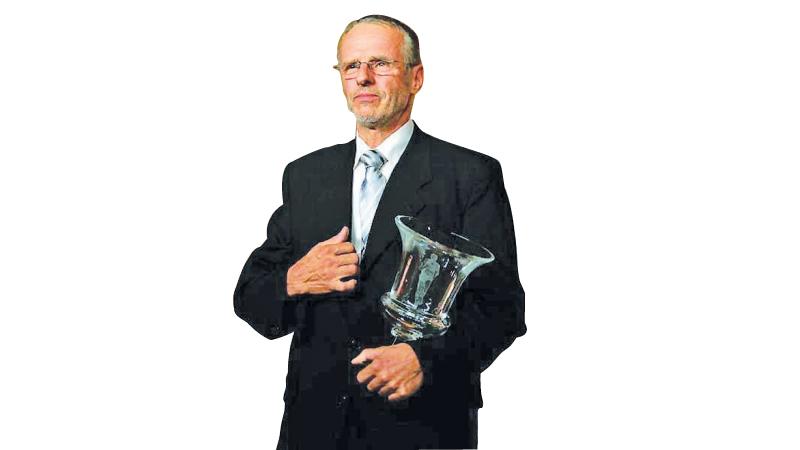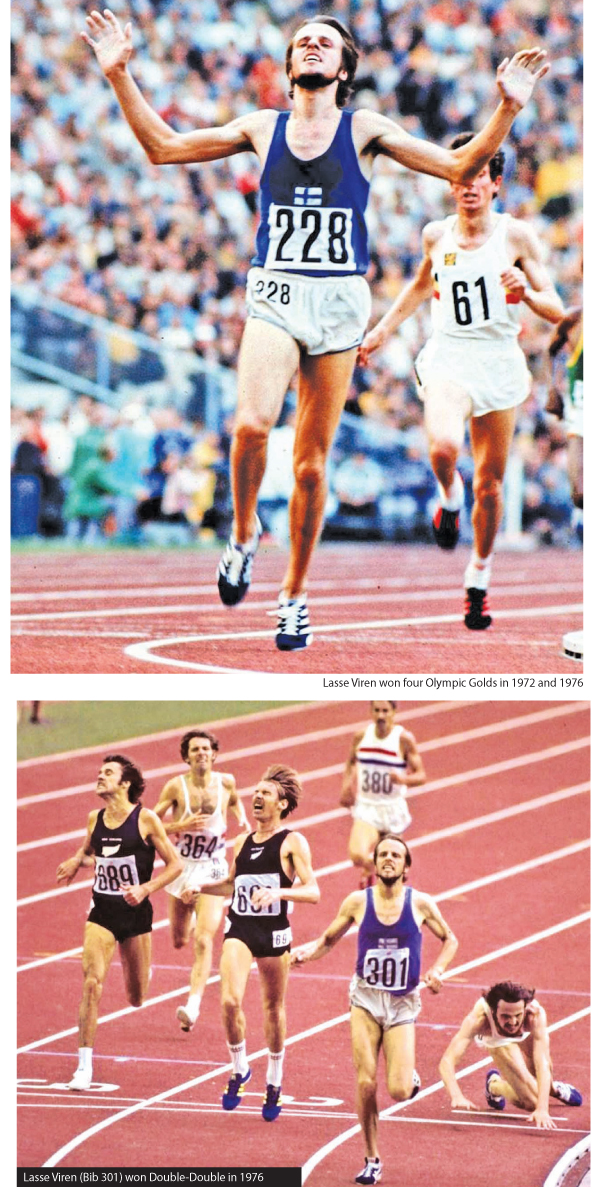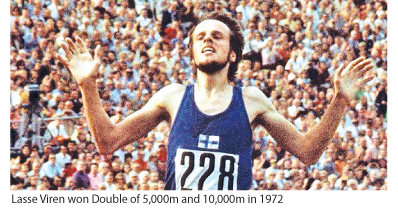
There was a mystic period of running history, and one name that continued to be the throne in the side of many of the world’s best was Finnish long-distance runner, Lasse Viren. He dominated the world scene, pocketing four gold medals across the 1972 and 1976 Summer Olympics. Viren was blessed with both talent and a gigantic work ethic and off the back of his rise the phrase was coined the “Flying Finns” that was established five decades earlier by Annes Kolehmainen, Paayo Nurmi and Ville Ritola in the 1920s.
Viren was just 23when he made his Olympic Games debut in 1972. His first event was the 10,000m and midway through the race, Viren was running in fifth place when he suddenly stumbled and fell. He rose quickly and moved up to second place within 230m. The lead changed hands several times. Then with 1½ laps to go, Viren applied pressure and his opponents, one by one, fell behind. Lasse won by six metres, breaking the seven-year world record. Ten days later, he won the 5,000m and successfully completed his maiden long-distance Olympic double.
After an Olympic cycle, at the 1976 Olympic Games in Montreal, Viren had an easier time in the 10,000m though Carlos Lopes led for most of the race. Lasse passed him 450m from the finish and won by 30 metres. The 5,000m was harder. Although Viren was in the lead at the beginning of the final lap, only five metres separated the first six runners. Coming out of the final turn, Viren beat back a fierce challenge by New Zealand’s Dick Quax and won his fourth Olympic gold medal.
Viren is the only repeat winner of the 5,000m. He returned to the Olympic Games in 1980, placing fifth in the 10,000m and, indisposed by an intestinal ailment, dropping out of the marathon. Viren was a strong supporter of training in the woods. He said: “The tranquility of nature creates mental strength. When you run in the woods, you will have to change rhythm to avoid roots, just in the same way as you have to be constantly alert in a competition.” He was elected Finnish Sportsman of the Year in 1972 and 1976.
Birth and Early Career
Lasse Artturi Viren, born on July 22, 1949, began his athletics career in the United States at Brigham Young University (BYU), in Provo, Utah. Viren ran on the Varsity Cross-Country team for BYU for one season, before returning home to his native Finland.
A police officer from Myrskyla, Viren debuted on the international scene in 1971. His performances at the 1971 European Championships in Helsinki were overshadowed by fellow Finn JuhaVaatainen, who captured gold medals in both the 5000 and 10,000 with Viren settling for modest 7th and 17th placings respectively.
Viren and his coach, Rolf Haikkola, later concluded that Viren could have placed better in the 1971 European Championships, if he had done the “emptying exercise” of his system earlier. According to Haikkola, he followed the Finnish Athletics Federation’s leaders’ bad advice and if he hadn’t been pushed almost to the point of falling at the start of the last lap in the 5000m final.
 The “emptying exercise” of top athletes means that they push their bodies to a total exhaustion or lack of energy so that their bodies can again receive much energy, and so that they can repeat their top race performances. Shortly after 1971 European Championships, he broke Vaatainen’s Finnish record at 5,000m.
The “emptying exercise” of top athletes means that they push their bodies to a total exhaustion or lack of energy so that their bodies can again receive much energy, and so that they can repeat their top race performances. Shortly after 1971 European Championships, he broke Vaatainen’s Finnish record at 5,000m.
Viren had broken the world records for both the 2-mile and the 5,000m outside the Olympic Games. Both were done in close proximity to the 1972 Olympics: his 8:14.0 for two miles was on August 14, 1972 whilst his 13:16.4 for 5,000m was on September 14, 1972.
Buoyed by a brutal training schedule in Thomson’s Falls in Kenya and very impressive results, which included the smashing of the 2-mile world record and wins against Great Britain and Spain in Helsinki in the summer of 1972, Lasse Viren entered the Munich Olympics as a dark horse.
Munich 1972 Olympic Games
The men’s 10,000mat Munich 1972 was held on August 31 and September 3 and featured a qualifying round followed since the Antwerp 1920 Olympics. The final was notable for Viren’s world record performance. At the start of the race, David Bedford of Great Britain led the pace; he maintained a world record pace at the 4000m mark, and he still led halfway through the race. On the 12th lap, just before the halfway point, Viren and Tunisia’s Mohammed Gammoudi, tangled into each other and fell onto the track. Both recovered, and while Gammoudi fell out of the race two laps later, Viren caught up to the front and passed Bedford to take the lead at about the 6000m mark.
With Viren leading for the rest of the race, the lead pack reduced to five competitors with 600m remaining when he made his charge. He ran the final lap (400m) in 56.4 sec; he won the gold medal, beating Emiel Puttemans of Belgium by 7m and setting a world record time of 27:38.35. The Guardian listed Viren’s world record performance as the greatest sport comeback of all time.
The Men’s 5,000m took place on September 7 and 10.Having won the 10,000m a week earlier, Viren controlled the pace through the first 2000m in 5:32.61. David Bedford, tired of the slow pace, passing Viren and leading a crowd to go around to a faster pace. As the pace accelerated, Javier Alvarez came from the rear around the field to take the point for the next kilometre. At 3200m, Nikolay Sviridov challenged for the lead.
Steve Prefontaine took the lead at 3400m. Over the next lap, Viren came from sixth place in line to mark Prefontaine. Viren was in turn marked by Emiel Puttemans. A five-man breakaway formed. With 850m to go, Viren passed Prefontaine. Down the back stretch, Prefontaine strained back into the lead. 50m before the bell, Viren took the lead again, with Mohammed Gammoudi breaking off the remaining group to mark the leaders.
Down the final backstretch, Gammoudi eased around Viren while Prefontaine hit almost a full sprint to get on Gammoudi’s shoulder. With 200m to go, Prefontaine relaxed and Viren moved ahead of him. Prefontaine surged again to keep pace. In the middle of the final turn, Viren changed gears into his full sprint, taking the lead and won in 13:26.4. Gammoudi couldn’t keep pace and began to watch Prefontaine while trying to hold on to the silver medal.
Mid-straightaway all three checked the position of their rivals as Prefontaine took one more surge after Gammoudi. As it was quickly clear he couldn’t make enough progress, Prefontaine strained. Ian Stewart came from the chasing group in full sprint gaining rapidly but Viren won.
One factor in Lasse Viren’s Olympic victories, especially 5,000m and 10,000mat the Munich 1972, that received little attention was his careful running of almost all the bends (curves) near the inner edge of the first lane, which spared him tens of metres compared to his main rivals.
More specifically, Steve Prefontaine gave Viren an advantage of more than 40m over 5,000m in 1972, while Emiel Puttemans gave about 50m over 10,000m, by running many bends wide on the outer edge of the first lane or sometimes even on the second lane. This metre-saving practice is called “bend (curve) mathematics.”
180 cm (5 ft 11 in) tall and 60 kg (132 lb) in weight, Viren became the fourth athlete to win both events in the same Olympics, joining fellow Finn Hannes Kolehmainen (1912), Czechoslovakia’s Emil Zatopek (1952) and Russian Vladimir Kuts (1956). After them, MirutsYifter (1980) and Kenenisa Bekele (2008), both from Ethiopia, and Mo Farah from Great Britain (2012 and 2016), accomplished the coveted “double.”
After a complex leg surgery in 1974, Viren won a bronze in the 5,000m at the 1974 European Championships in Rome. Two days later, in Helsinki, he won a 5,000m. Then, Viren recorded his fastest 10,000m for the 1974 season with a winning time of 28:22.6 at a Finland vs. Soviet Union international meet.
Montreal 1976 Olympic Games
At the 1976 Summer Olympics, Viren again won both events, coined later as the ‘Double-Double,’ and became the first repeat winner of the 5,000m in Olympic history, since joined by Mo Farah. The final of 10,000mwas held on July 26, after the qualifying heats were run on July 23, 1976.
This final started slowly, with Britain’s Anthony Simmons leading at 1,000m. However, before 2,000m there was some pushing in the tightly bunched field. As a result, Norway’s Knut Boro injured one of his legs, and he was forced to drop out. The pace only improved slightly through 2,000m and 3,000m. Around 3,300m, Portugal’s Carlos Lopes took the lead for the first time, but he was shortly thereafter passed by Simmons.
Lopes led the field at 4,000m. During the fifth kilometre, he slowly accelerated the pace by over 3 sec. At 5,000m, Lopes’s time was 14:08.94. By 6,000m, several runners had already dropped from the lead group. At 6,800m, the discouraged Puttemans dropped out of the final. Lopes’s exhausting pace continued through 7,000m (19:36.34), shortly after which Smet dropped from the top runners’ group. Foster was the next runner to lose contact with Lopes, at 8,000m (22:20.19).
Lopes led still at 9,000m (25:02.88), with Viren remaining close behind him. Around 9,550m, Viren at last moved out from the first lane’s inner edge, in order to pass Lopes. The tenacious Portuguese runner could not accelerate his pace, and thus Viren easily and quickly broke away from him.
 Following Viren’s10,000m final win at the Montreal, he took off his shoes and waved them to the crowd on his victory lap. The International Olympic Committee (IOC) accused Viren of malicious intent, such as showing the tiger stripe logo on the shoes, but he claimed that he had a blister. Thus, the IOC suspended Viren from taking place in the 5,000m final after qualifying in his heat. An appeal followed and he was allowed to enter the race, two hours before gun time.
Following Viren’s10,000m final win at the Montreal, he took off his shoes and waved them to the crowd on his victory lap. The International Olympic Committee (IOC) accused Viren of malicious intent, such as showing the tiger stripe logo on the shoes, but he claimed that he had a blister. Thus, the IOC suspended Viren from taking place in the 5,000m final after qualifying in his heat. An appeal followed and he was allowed to enter the race, two hours before gun time.
The final of Men’s 5,000m was held on July 30, after the three qualifying heats were run on July 28, 1976. At first, the Soviet Union’s Enn Sellik led this final, but then he let the other Soviet runner, Boris Kuznetsov, pass him. Before 400m, one of the pre-race favourites, Britain’s Brendan Foster, took the lead. He led the field through 1,000m and at 2,000m. After 2,100m, Viren passed Foster, but surprisingly slowed the pace down. He jogged the next two laps in the lead, passing 3,000m in 8:16.23.
At once after 3,000m, Foster accelerated into the lead, sprinting the next 200m in about 30 sec. After that burst of speed, he slowed down, and was passed by West Germany’s Klaus-Peter Hildenbrand before 3,400m. At that point, Norway’s Knut Kvalheim rose to the second place. Around 3,700m, Finland’s Pekka Paivarinta dropped from the leading group. Before 3,800m, Viren accelerated into the second place. After 3,900m, Hildenbrand let Viren pass him on purpose.
At 4,000m, Viren led in 10:55.41. Around 4,250m, Kuznetsov tripped on the left leg of New Zealand’s Rodney Dixon, and fell to the track, unable to continue the race because of his injury. Due to this incident, Sellik, West Germany’s Detlef Uhlemann and Norway’s Knut Kvalheim began to drop from the leading group. Portugal’s Aniceto Silva Simoes caught the six leaders before 4,400m.
At 4,600m, Viren led the race, followed by Britain’s Ian Stewart and Foster, New Zealand’s Dixon, West Germany’s Hildenbrand, New Zealand’s Dick Quax, and Portugal’s Simoes. The Portuguese runner dropped from Viren’s pace in the front bend. On the final back straight, Viren visibly picked up his speed, dropping Stewart from the second place to the sixth place by 4,800m.
At that point, Viren led the race by around half a metre, threatened by Dixon and Hildenbrand. On the final bend, Quax furiously kicked past Foster, Dixon and Hildenbrand, and drew nearly level with Viren before the home straight. The Finnish Olympic champion was still able to accelerate, however, leaving Quax with the silver medal. Hildenbrand assured the bronze for himself by lunging across the finish line.
The top four runners sprinted to the finish line inside six metres, a rare occurrence in major international championships. Viren competed in the men’s marathon, his first and finished fifth in 2:13:11.
Moscow 1980 Olympics and Retirement
Viren ended his career after the Moscow 1980 Olympics, where he was placed fifth in the 10,000m. He pushed that final’s leading pack until the last 300m, before succumbing to the spurt of Miruts Yifter, the eventual gold medalist. Some people claimed that Viren could have run better in the 1980 Olympics if he had not done so much marathon-like training.
Viren believed that he would have run clearly better if he had not injured his leg shortly before the Olympics. He skipped the 5,000m and chose to compete in the Olympic marathon, where he started quite well, running over 20 km in the lead group. Stomach problems, however, caused him to drop out before 30 km. In the autumn of 1980, he announced his retirement from athletics.
Viren’s success outside the Olympics in running near his best Olympic-year times was better in 5,000m than in 10,000m. He broke 13:36 in the 5,000m consistently outside Olympic years and sometimes even broke 13:30. At 10,000m, he only broke 28 minutes in the Olympic years.
His Personal Best achievements: 1500m - 3:41.8 (Lappeenranta 1976); 3000m - 7:43.6 NR (Oulu 1972); 2-mile - 8:14.0 (Stockholm 1972); 5000m - 13:16.4 NR (Helsinki 1972); 10,000m - 27:38.35 (Munich 1972); Marathon: 2:13:11 (Montreal 1976).
Established in 1977 by the Finnish sculptor Eino, the Lasse Viren Finnish Invitational, later the “Lasse Viren 20K,” was an annual race in Sycamore Canyon, California, held through 2012. Viren started the London 10km road race in 2012, “It is a great honour to be asked to start this new race. It’s been a long time since I was winning Olympic races but I’m excited to get this great new event underway and then run part of the 2012 Olympic marathon route with my son Matti.”
Since Viren’s career ended, he has become a well-known figure in his homeland Finland, eventually holding a seat in the Finnish Parliament with the National Coalition Party from 1999 until 2007 and from 2010 to 2011. In 2014, Viren was inducted into the IAAFs’ ‘Hall of Fame.’
(The author is an Associate Professor, International Scholar, winner of Presidential Awards and multiple National Accolades for Academic pursuits. He possesses a PhD, MPhil and double MSc. His email is [email protected])
